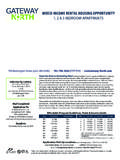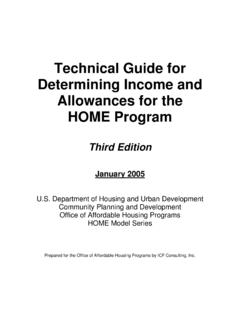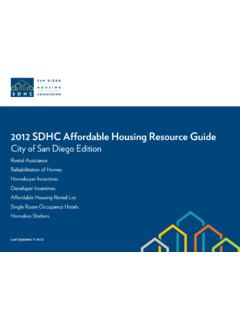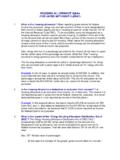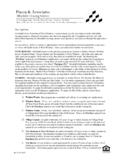Transcription of INCOME AND ASSET GUIDEBOOK FOR …
1 11A Part 5, 01 Household Eligibility Requirements, 1 MICHIGAN STATE HOUSING DEVELOPMENT AUTHORITY COMMUNITY DEVELOPMENT DIVISION PB 11A PART 5 INCOME AND ASSET GUIDEBOOK FOR HOMEOWNER AND RENTAL REHABILITATION PROGRAMS Grant administrators of the Community Development Division (CD) funds must certify that program recipients meet the Housing and Urban Development (HUD) and Michigan State Housing Development Authority (MSHDA) eligibility requirements. Therefore, CD has prepared this INCOME and ASSET GUIDEBOOK , as revised Policy Bulletin 11, to provide direction in Household Eligibility Requirements, INCOME , Assets and the Third Party Verification (TPV) Process. HOUSEHOLD ELIGIBILITY REQUIREMENTS Area Median INCOME (AMI) Limits CD grant funds are reserved to benefit low-moderate INCOME families and, depending on the type of program, the following maximum INCOME limits apply: Program Gross Annual INCOME at or below Homeowner Assistance 80% AMI home Rental Rehabilitation 60% AMI CDBG Rental Rehabilitation 80% AMI CDBG-assisted multiple units structures must have at least 51% of units occupied by low-mod INCOME households.
2 If structure has two units, at least one must be occupied by a low-mod INCOME household. CDBG-assisted area benefit activities undertaken in a Neighborhood Preservation Program (NPP) area or Neighborhood Revitalization Area require activity to benefit all residents in area ( , street improvements, water and sewer, neighborhood facilities, etc.) and at least 51% of area s residents are at or below 80% AMI. AMI limits are determined by HUD and are posted at Citizenship Pursuant to the Welfare Reform Act in 1966 and Section 401 of Title IV of the Personal Responsibility and Work Opportunity Reconciliation Act of 1996 (PRWORA), a Federal public benefit for public or assisted housing requires verification of legal residency in this country before providing assistance.
3 Each household member must complete the Declaration of Section 214 Status form and attach documents as required. 11A Part 5, 01 Household Eligibility Requirements, 2 For information about immigration services, contact the Citizenship and Immigration Services, Detroit District Office, 1-800-375-5283 or visit their website online at Household Size INCOME limits are adjusted by household size; therefore, one of the first steps in determining eligibility is to determine the size of the household. Some households may have members whose INCOME , if any, is not considered when calculating annual INCOME . Do not count the following household members when determining family size or annual INCOME : Foster Children Live-in Aides Children of Live-In Aides Unborn Children Children Being Pursued for Legal Custody or Adoption who are not currently living with the household.
4 Note: A child in a shared-custody agreement and resides in the household at least 50% of the time can be counted as a household member. Restrictions on Assistance to Students Enrolled in an Institution of Higher Education For home and home PI activities only This section applies only to full time and part time students who are seeking assistance on their own, separately from their parents. It does not apply to students residing with parents who are seeking or receiving assistance. The 2013 Rule specifically excludes certain students from participating independently in the home program. The home program adopts the Section 8 Housing Choice Voucher (HCV) program restrictions on student participation found at 24 CFR If a student enrolled at an institution of higher education is under the age of 24, not a veteran, not married, does not have a dependent child, and is not a person with disabilities then the student s eligibility must be examined along with the INCOME eligibility of the student s parents.
5 In these cases, both the student and the student s parents must be INCOME eligible for the student to receive assistance. If, however, a student in these circumstances is determined independent from his/her parents in accordance with MSHDA policy, the INCOME of the student s parents will not be considered in determining the student s eligibility. 11A Part 5, 01 Household Eligibility Requirements, 3 To verify student s independence from parents, all of the following must be provided: Proof student has established a household separate from parents for at least one year. Prior year INCOME tax returns to verify parents did not claim student as dependent. Written certification from parents identifying amount of support they will be providing to student, even if the amount of support is $0.
6 If documentation is not provided then the student is prohibited from receiving any type of home assistance, including renting home -assisted rental units, receiving home tenant-based rental assistance, or otherwise participating in the home program. FOR RENTAL PROGRAMS AT ANNUAL RECERTIFICATION: This restriction must be reviewed at the time of each annual recertification. Grantees, property managers, landlords and/or owners must ensure at each annual recertification that a student remains eligible (as notated above including parent certifications, etc.) to receive home assistance under the restrictions of this law as stated in the Supplementary Guidance Notice published in the April 10, 2006 Federal Register (72 FR18146).
7 Whose INCOME to Count See Policy Bulletin 16 for additional Household Eligibility Requirements. Adult Full-Time Dependent Students Living Away From home . If the adult full-time dependent student is counted as a member of the household in determining household size (to compare against the HUD INCOME limits), up to $480 of the student s INCOME must be counted in the family s INCOME . Use source document or School Verification form. Note: The $480 annual limit does not apply to a student who is the head of household or spouse; their full INCOME must be counted. Live-in Aides. If a household includes a paid live-in aide (whether paid by the family or a social service program), the INCOME of the live-in aide is not counted, regardless of the source.
8 Except under unusual circumstances, a related person cannot be considered a live-in aide. Use source document or Verification of Disability and/or Special Medical Needs form. Marital Separations. All parties with a legal interest in the property, including both spouses, must sign the lien agreement. Eligibility requirements for parties that are separated differ depending on the type of program as follows: For Homeowner Assistance programs, a married applicant who is separated may be eligible if: The separated spouse has not lived in the property for at least six months prior to the date of application, AND The separated spouse can document a separate address (driver s license, lease, utility bill, etc.)
9 , AND Separation status and INCOME and/or support payments are verified by a Judgment of Separate Maintenance OR a notarized affidavit (see Note below) signed by the applicant. 11A Part 5, 01 Household Eligibility Requirements, 4 For Rental Rehabilitation programs, a married applicant who is separated may be eligible if: Applicant can provide proof of separation ( , separate addresses, court documentation, etc.) and it is at least six months prior to the date of application, AND Separation status and INCOME and/or support payments are verified by a Judgment of Separate Maintenance OR a notarized affidavit (see Note below) signed by the applicant. Note: The notarized affidavit should state the following: 1.
10 Name and addresses of both parties, 2. date of separation, 3. date divorce proceedings will begin, 4. alimony payments are being made to either party and amount, 5. child support payments being made to either party and amount, 6. other payments and amount, and 7. other pertinent information regarding this separation. Minors. Earned INCOME of minors (age 17 and under) is not counted. Unearned INCOME attributable to a minor is counted ( , child support, Temporary Assistance for Needy Families (TANF) payments, disabled child who receives SSI, other benefits paid on behalf of minor). Permanently Absent Family Member. If a family member is permanently absent from the household (such as a spouse who is in a nursing home ), the head of household has the choice of either (i) counting that person as a member of the household and include their INCOME or (ii) specify that the person is no longer a member of the household.











